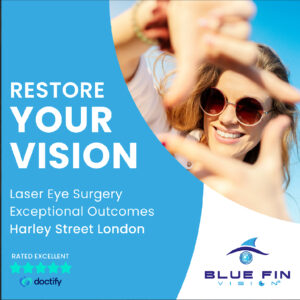Refractive lens exchange (RLE) continues to be a popular and innovative solution for those who are seeking a long-term remedy for vision issues that impact daily life. As people age or develop refractive errors, such as nearsightedness, farsightedness, or astigmatism, RLE provides a unique and permanent alternative to glasses and contact lenses. Additionally, it addresses presbyopia, which typically emerges in middle age and affects the eye’s ability to focus on close objects. Unlike other corrective surgeries, RLE goes a step further by replacing the natural lens of the eye with a synthetic intraocular lens (IOL) designed to meet the individual’s specific vision needs.
A key advantage of RLE is that it caters to people who may not be ideal candidates for LASIK surgery. For instance, individuals with high levels of refractive errors or thin corneas are often excluded from LASIK procedures, as the laser reshapes the cornea to improve vision. In contrast, RLE doesn’t involve the cornea at all; it focuses on replacing the lens, making it an effective solution for a broader range of people, including those with severe refractive issues. By addressing both near and distance vision simultaneously, RLE reduces the reliance on glasses for activities ranging from reading to driving.
For those experiencing presbyopia, RLE offers a transformative solution. As people reach their 40s or 50s, they often find it difficult to read small print or focus on objects up close. This can result in a need for reading glasses or bifocals. In an RLE procedure, the surgeon replaces the eye’s natural lens with a multifocal or accommodative IOL, which restores Refractive lens exchange the eye’s ability to focus on objects at various distances. This eliminates the need for reading glasses and can greatly improve the quality of life for patients who have been frustrated by their deteriorating vision.

In addition to correcting presbyopia, RLE also provides lasting results for patients with significant refractive errors. Individuals with high myopia (nearsightedness), hyperopia (farsightedness), or astigmatism, who may not be eligible for LASIK or other laser treatments, can benefit from RLE’s ability to address multiple vision issues at once. This procedure is especially beneficial for older patients who may have developed cataracts or other lens-related vision problems. Even without the presence of cataracts, RLE can offer superior vision correction that far exceeds the capabilities of glasses or contact lenses.
The procedure itself is highly efficient and minimally invasive. A small incision is made in the cornea, and the natural lens is carefully removed. The artificial IOL is then inserted into the eye, where it remains permanently. The IOL can be chosen based on the patient’s unique needs, offering options such as monofocal lenses for single-distance clarity or multifocal lenses for all-around vision. After the procedure, most patients experience only mild discomfort, such as dry eyes or slight blurriness, which resolves relatively quickly. Full recovery usually takes only a few weeks, and the patient can often return to normal activities within days.
While the recovery process for RLE is generally fast, some potential risks are associated with the procedure. As with any surgery, complications such as infection, inflammation, or dislocation of the IOL can arise, though these are rare. In some cases, patients may experience temporary visual disturbances, including glare or halos around lights. However, these effects tend to diminish over time as the eye heals. It’s also worth noting that while RLE offers significant benefits for many, it may not be suitable for everyone, particularly those with certain underlying eye conditions or unrealistic expectations about the outcomes.
Despite the minor risks, the benefits of RLE make it an appealing option for many individuals seeking a permanent solution for refractive errors. The ability to correct vision across multiple distances, such as near, intermediate, and far, makes it an attractive choice for those looking to regain independence from corrective lenses. For older adults, the procedure provides a way to manage the effects of presbyopia and other age-related vision changes, without the constant need for reading glasses. Furthermore, the high success rate of RLE surgeries, combined with advanced technology in IOLs, means that most patients experience significant improvements in their vision, leading to a better quality of life.
In conclusion, refractive lens exchange is a highly effective and increasingly popular solution for individuals looking to correct a variety of vision problems. Whether for severe refractive errors or presbyopia, RLE offers a permanent, safe, and life-changing alternative to traditional corrective eyewear. The procedure is particularly beneficial for people over 40 who are struggling with near-vision issues and for those who are not suitable candidates for LASIK. As technology continues to improve, the options for customized IOLs will expand, providing patients with even more ways to achieve optimal vision. For many, RLE represents a transformative opportunity to enhance their vision and overall quality of life.